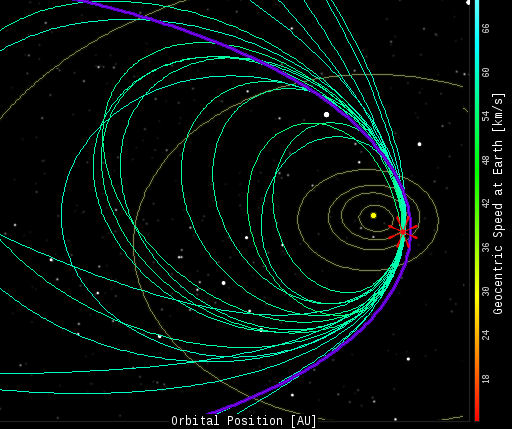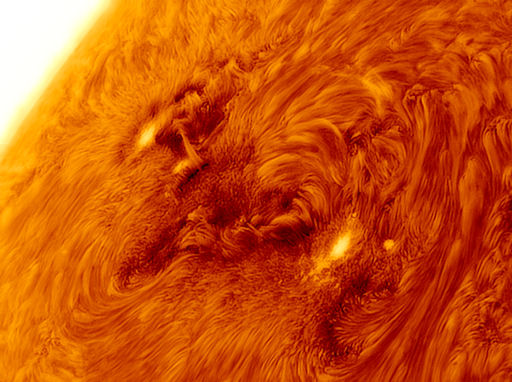Listen to radar echoes from satellites and meteors, live on listener-supported Space Weather Radio. | | |
STRANGE BUT TRUE: CURIOSITY'S SKY CRANE: How do you deposit a massive SUV-sized nuclear-powered rover to the surface of an alien planet without making an SUV-sized crater? NASA's solution for Curiosity will be attempted for the first time on August 5/6 when they gently lower the rover to the red sands of Mars using a Sky Crane. [full story] [video: Mars Landing Sky Show]
EARLY PERSEID METEORS: Earth is entering a broad stream of debris from Comet Swift-Tuttle, source of the annual Perseid meteor shower. Meteoroids in the outskirts of the stream are now hitting Earth's atmosphere, producing as many as 10-15 meteors per hour according to worldwide counts from the International Meteor Organization. NASA's network of all-sky meteor cameras captured 17 Perseid fireballs on the nights of July 28th through 30th. Here are their orbits:

The position of Earth is denoted by the red starburst; all of the meteoroid orbits intersect at that point. The purple line traces the orbit of the parent Comet Swift-Tuttle. Fortunately, the comet itself does not intersect Earth.
In the days ahead, Earth will plunge deeper into the meteoroid stream, and meteor rates will increase accordingly. Forecasters expect the shower to peak on August 12-13 with as many as 100+ meteors per hour visible from dark-sky sites. Monitor the realtime meteor gallery for sightings.
Realtime Meteor Photo Gallery
SUBSIDING MAELSTROM: Sunspot AR1532 has been active, producing an M-class flare almost every day since it appeared last Friday. On July 28th, amateur astronomer Viljo Nylund of Finland photographed the maelstrom of hot plasma surrounding the sunspot's dark core:

Nylund used an H-alpha telescope tuned to the red glow of solar hydrogen. "The area around AR1532 looked very active and interesting, so I decided to try my luck. I made an inverted version of the image to highlight the 3D feel."
The maelstrom might be subsiding. A full day has gone by without a significant flare, and the active region's underlying spotted area is decreasing. NOAA forecasters estimate the chances of an M-class flare today to be 35%. Solar flare alerts: text, voice.
Realtime Space Weather Photo Gallery
Realtime Noctilucent Cloud Photo Gallery
[previous years: 2003, 2004, 2005, 2006, 2007, 2008, 2009, 2011]
Potentially Hazardous Asteroids (
PHAs) are space rocks larger than approximately 100m that can come closer to Earth than 0.05 AU. None of the known PHAs is on a collision course with our planet, although astronomers are finding
new ones all the time.
On July 31, 2012 there were 1324 potentially hazardous asteroids.
Notes: LD means "Lunar Distance." 1 LD = 384,401 km, the distance between Earth and the Moon. 1 LD also equals 0.00256 AU. MAG is the visual magnitude of the asteroid on the date of closest approach. | | The official U.S. government space weather bureau |
| | The first place to look for information about sundogs, pillars, rainbows and related phenomena. |
| | Researchers call it a "Hubble for the sun." SDO is the most advanced solar observatory ever. |
| | 3D views of the sun from NASA's Solar and Terrestrial Relations Observatory |
| | Realtime and archival images of the Sun from SOHO. |
| | from the NOAA Space Environment Center |
| | the underlying science of space weather |

